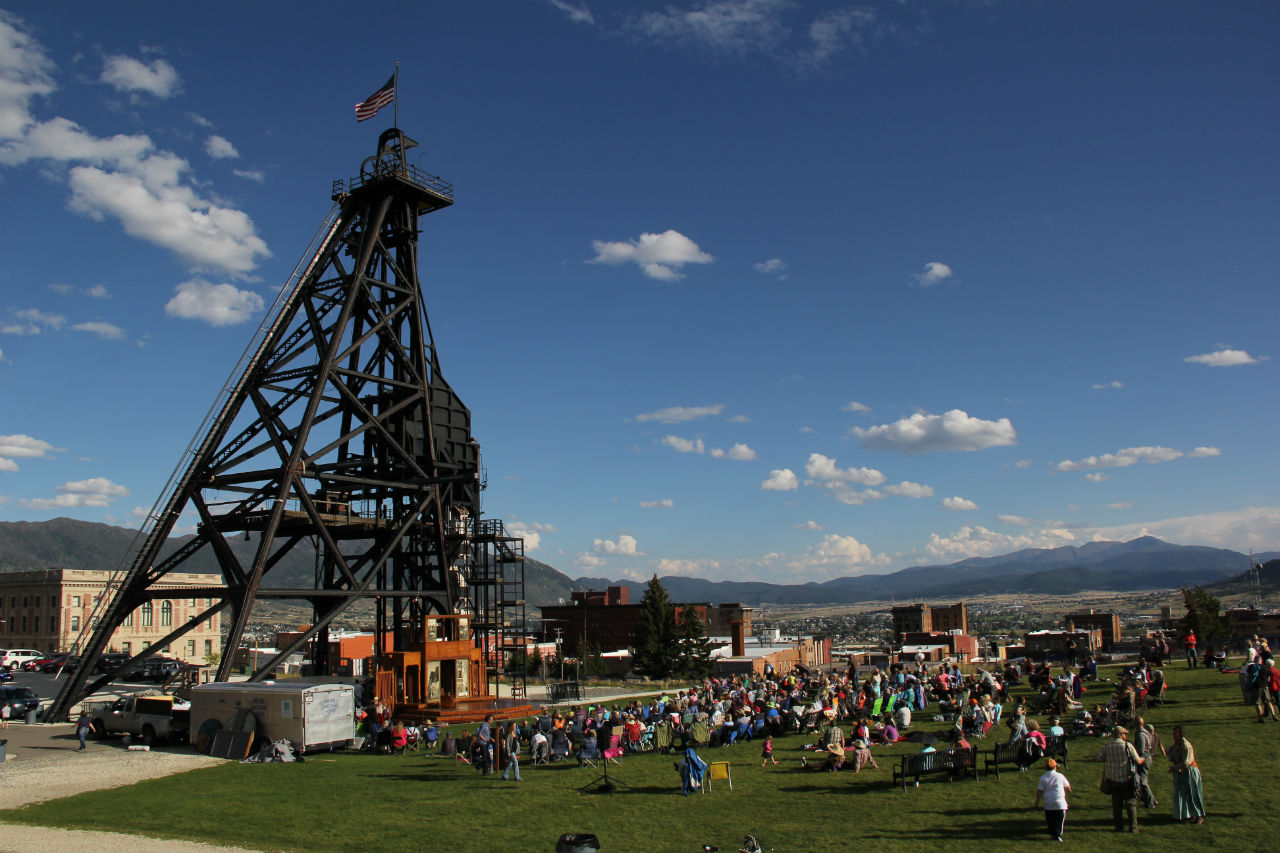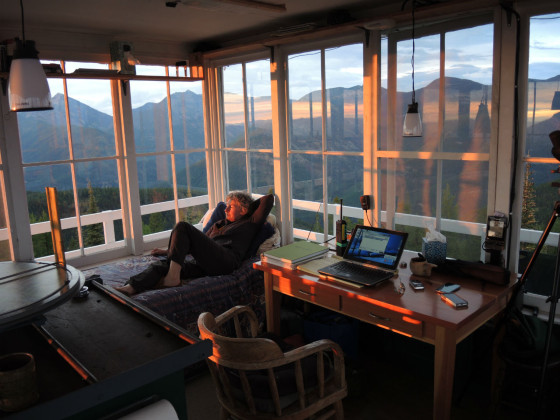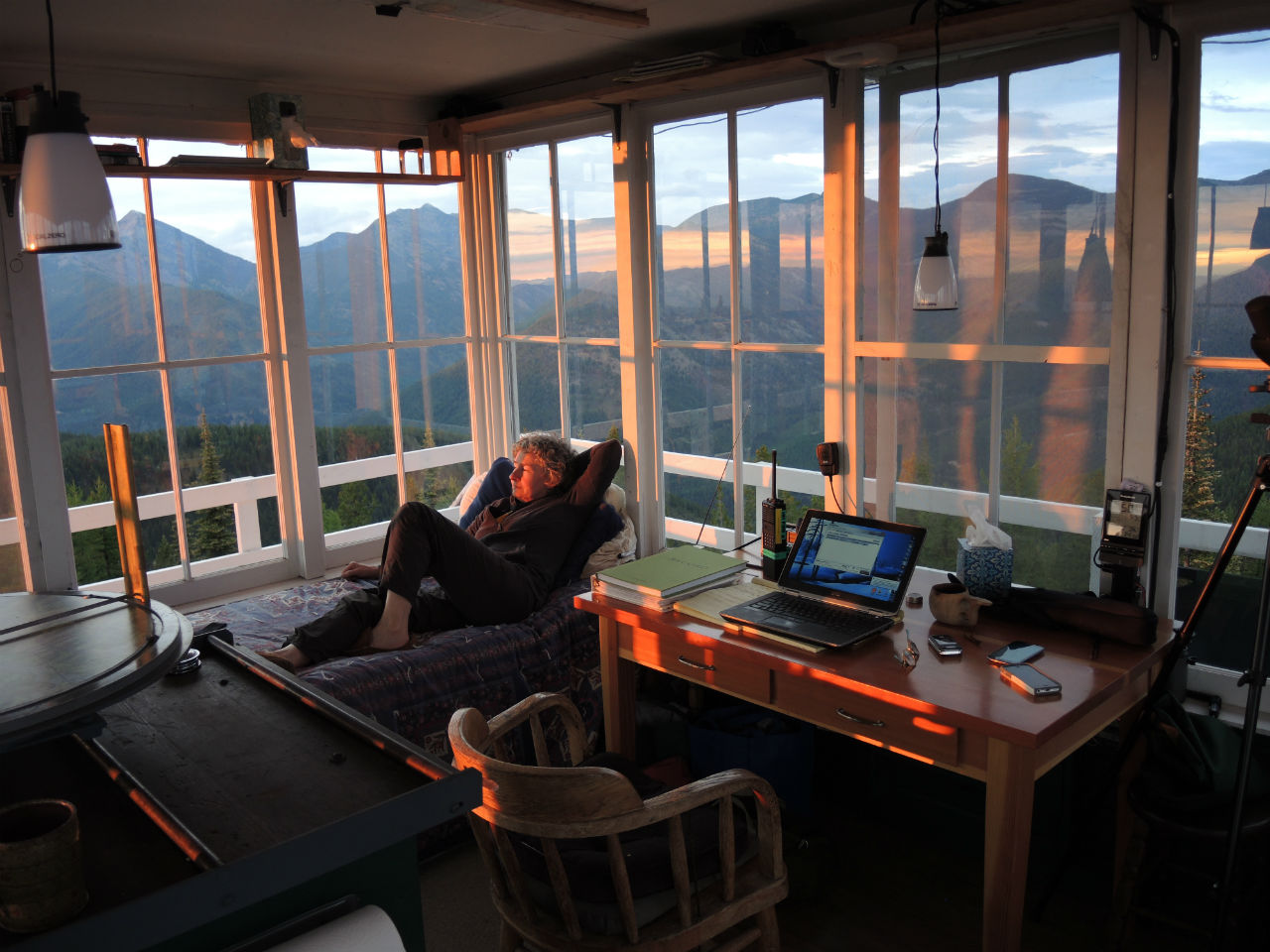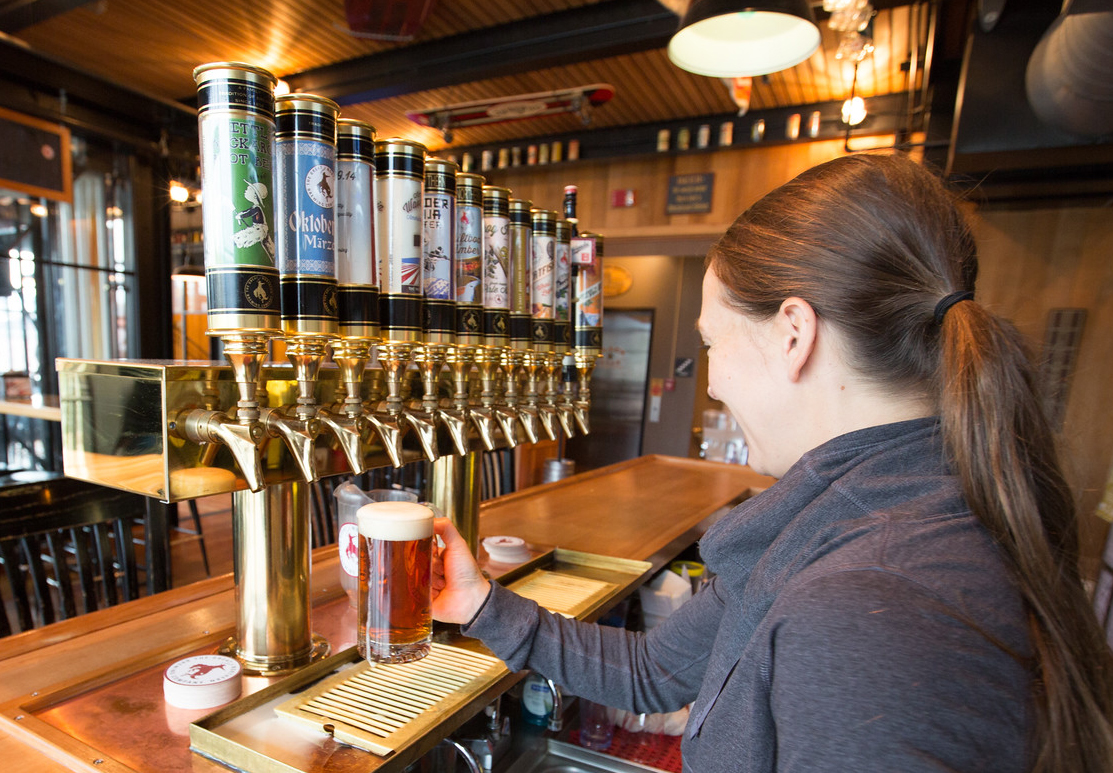1. Flathead Lake (south of Kalispell)
The largest freshwater lake in the West, Flathead Lake is ringed by 185 miles of shoreline where you’ll find quiet bays and swimming beaches, islands and parks. The largest island on the lake is called Wild Horse Island, which is apt — visit for the beaches and hiking trails that wind through old-growth ponderosa forest and you may well bump into the local wild horses while you’re at it. Look out for bighorn sheep, coyotes, deer, bald eagles, and falcons too.
Flathead is bordered by the Mission and Salish Mountains, and along the its shores are several small towns that serve as great bases for getting out on the water and nearby biking and hiking trails. Polson, Lakeside, and Somers are all lively spots during summer and ideal for seeking out SUP boarding, kayaking, fishing, boating, and sailing outfitters.
Known as the village by the bay, Bigfork provides direct access to Flathead Lake; it’s filled with locally owned boutiques, galleries, and restaurants. Dine by the water at The Raven in Woods Bay, then head to the Bigfork Summer Playhouse for some theater.
Get there: Flathead Lake’s east shore is traced by Highway 35, while the western side is bordered by US Route 93. Glacier National Park is 30 miles to the north, Missoula 70 to the south.
2. Triple Divide Pass (Glacier National Park)
Rangers will tell you that if you were to empty your canteen on top of Glacier National Park’s Triple Divide Peak, the water would find its way to the Arctic, the Atlantic, and the Pacific Oceans. The park, because of its position amidst the vast watersheds of North America, has been christened the hydrological apex of North America — or, more majestically, the Crown of the Continent.
The jewels on this crown have, for the past 7,000 years, been luminescent white masses of ice and snow — sparkling ornaments on an already impressive backdrop. Glaciers carved out this landscape, and they remain in the form of frozen slow-moving giants, high-elevation gems whittling away at the peaks and the rock, still sculpting the venerable Rocky Mountain ranges that are on full display from Triple Divide. On the climb up to Triple Divide Pass, you’ll gain nearly 3,000 feet of elevation and hike over streams, through dense forests, past skyscraper-high waterfalls, and eventually up to incredible top-of-the-world vistas.
Get there: The trailhead for Triple Divide Pass is in the Cut Bank area of the eastern portion of Glacier National Park, off Route 89. Turn west on the Cut Bank Creek Road, 17 miles north of East Glacier. You’ll find the Pitamakan Pass trailhead at the end of this 5-mile gravel road, just past the Cut Bank Ranger Station. There’s a small parking area, and the Cut Bank campground is right there if you want to spend a night (or three).
The Pitamakan Pass Trail is the starting point for the hike to Triple Divide Pass (and others). Triple Divide Pass is just over 7 miles one-way, and is rated by the National Park Service as a “moderate” hike (aka: Come prepared, and bring lots of water and snacks). And if you’re not up to the climb, walk along the valley bottom. It’s incredible too.
3. Fire lookouts (all over)
Montana is often lauded as a wild, remote state that’s mostly empty, but it’s still possible to end up in a crowd or a traffic jam. If you want some real Walden-style solitude, go in the shoulder season or skip the tourist attractions.
And if hiking up to a rustic cabin with 360-degree views of the mountains, carrying in all your food and water, and snuggling next to a woodstove in the middle of nowhere for day after lonesome day sounds like your idea of a good time, maybe you should have just been a fire lookout observer. No need to apply for a job, though, because in Montana fire lookout towers that are no longer in use are available to rent. Some of them are accessible by ski or snowshoe, but many open to hikers in May or June. You can book online up to six months in advance.
Get there: It’s up to you! There are many lookouts to choose from. Just make sure to check how big of a hike you’re signing up for before booking. Some are short jaunts, while others will be much more grueling and require a couple of days’ worth of supplies.
4. Goat Haunt (Glacier National Park)
The National Park Service calls the Goat Haunt Ranger Station one of Glacier National Park’s most “remote and tranquil locations,” and if you go there at the right time of day, it’s true. A tour boat arrives several times a day from Canada, but you can also hike in and enjoy the world’s longest unguarded border all to yourself. If you cross the border, you’ll have to check in with customs in either country, but this frontier — a human-drawn line down the middle of the world’s first International Peace Park — is a rare spot where you can stand with your feet in two countries, no guards in sight.
Hikers can start in Canada, or leave from many different locales within Glacier National Park. Rangers and locals earn their chops by hiking (sprinting?) from Logan Pass to Goat Haunt in one day — “The Dash,” as it’s known locally, is 30 miles, 4,400 vertical feet, and a handful of mountain passes — and is best done in the summer months when the days are long. Apply for a backcountry camping permit before or on the day (permitting locations vary) or hike the much gentler lakeshore from Canada. Hiker shelters at the ranger station make camping among Steller’s jays, moose, and lodgepole pine easy.
Get there: Goat Haunt is accessible only by foot or by boat. Tickets for boat cruises can be purchased in Canada’s Waterton Lakes National Park (the other half of the Waterton-Glacier International Peace Park). If you want to plan a summer backpacking adventure, the sooner the better. Reservations for backcountry camping sites open March 15 — otherwise you’ll be trying your luck at walk-in sites.
5. Great Northern Brewing Company (Whitefish)
The supply of craft brews in Montana seems to be ever increasing, and this 21-year brewing veteran sets a good example for the newcomers. The brewery and draught house, both in the tallest building in Whitefish (three stories!), host weekly cribbage tournaments and occasional live music.
Whitefish is the cool, laid-back ski-bum town of western Montana, with no shortage of huckleberry themes: a Huckleberry Days Arts Festival, a huckleberry-dessert bake-off, and so on. If you’re looking to relax in a ski town near the train station, sipping some Huckleberry wheat beer, the Great Northern Draught House is the place. It’s full of nostalgic national-parks kitsch, and you can decide for yourself if beer does taste different when it’s brewed with “glacial water.”
Get there: A two-minute walk from the Amtrak station, the brewery is also within walking distance of anything in downtown Whitefish, including the Whitefish Theatre Company, so you can make it dinner and a show.
6. Ends Well Antique and Supply (Babb)
Babb, a small, unincorporated ranching community, got its start as a post office in 1905. It still has a post office, now joined by at least ten other buildings. Near the east entrance to Glacier National Park, Babb is spread out along the highway, and if you stop at Ends Well Antique and Supply, you’ll find treasures from days gone by. Whether you need an oil lamp, an elk antler, or two dozen pairs of cowboy boots, this is the place. An afternoon digging through trinkets is well rounded with a pint and a meal — the steak dinners and homemade bread are legendary — at the Cattle Baron Supper Club, just down the highway.
Get there: Babb is a smattering of buildings along Route 89. Drive 8 miles north from St. Mary or 10 miles south from Canada and you’ll find Babb.
7. Chief Mountain (Blackfeet Reservation / Glacier National Park)
Arguably one of the most striking peaks in Montana, Chief Mountain is near the Canadian border and watches over the vast plains that stretch east of the Rockies. Half of Chief Mountain is in Glacier National Park and half is in the Blackfeet Reservation to the east, one of seven Native American reservations in Montana. In the Blackfoot language, the mountain’s name is Nínaiistáko. For the people of the Blackfoot Confederacy, which includes communities on both sides of the border, Chief Mountain was a cornerstone that defined their territory for millennia. The mountain is hard to miss and served as a landmark for travelers in the region.
It’s worth it to get up before the sun, drive up the Chief Mountain Highway, pull off at one of the many pullouts, and watch the sun rise over the steep and lofty cliffs to the west and flat prairies to the east. Bring a thermos and a picnic breakfast and marvel that this mountain has been standing guard here over so many changes.
If you want to get closer to Chief Mountain, it’s possible to hike along its base or up to its peak, but you’ll need to get a permit from the Blackfeet Tribe. In the summer, a road on Blackfeet land will lead you basically to the base of the mountain (with permission).
Get there: If you drive north on Route 89 from Babb, the Chief Mountain Highway forks off to the left before the Canadian border. It’s marked as Highway 17. Enjoy the view as you climb up and up (and up), but be wary of the free-range cattle that hang out on the highway (they’re black, so be extra cautious if you’re driving at night).
8. Polebridge Mercantile (Polebridge)
Is it worth driving an hour from Columbia Falls for a cinnamon bun or a huckleberry bear claw? Quite possibly. The Polebridge Mercantile houses an off-the-grid bakery, restaurant, and general store, and a chance to enjoy a remote outpost founded in 1914, in an area traveled by Kootenai/Ktunaxa people for millennia.
The National Parks Service recommends channeling some inner zen while driving the “dusty, bumpy, and slow-going North Fork Road” by imagining how much harder it would have been in 1914…so no complaining in your air-conditioned car. The road is beautiful and, if you have the time, worth a day trip. Hike the nearby trails, scope out swimming holes in the Flathead River, and rent a cabin to stay a while. The Northern Lights Saloon & Cafe will serve you a coffee in peak season, with huckleberry pie to boot.
Get there: From Columbia Falls, head north on the North Fork Road. The 36-mile drive mostly follows the bends and twists of the North Fork of the Flathead River, protected as a Wild and Scenic River since 1975.
9. Montana Shakespeare in the Parks (all over)

Photo: Montana Shakespeare in the Parks
Montana isn’t necessarily synonymous with British playwrights, but its Montana Shakespeare in the Parks project quickly dispels any myths that the state is nothing more than a far-flung outpost without any outside cultural influences.
Every season, Shakespeare in the Parks travels to 60-some towns across Montana, performing for free in parks in towns that, for the most part, have a population of fewer than 2,000. This year it’s Richard III and The Comedy of Errors, and it’s worth checking the schedule, packing a picnic, and heading to a town you otherwise might never have thought about visiting.
Get there: Choose your adventure. Check the website for dates in towns you’ve never heard of. Seeley Lake? Cut Bank? Shakespeare in the Parks performs in bigger centers as well, including Missoula and Whitefish.



